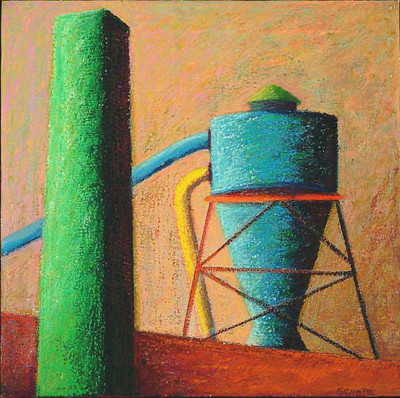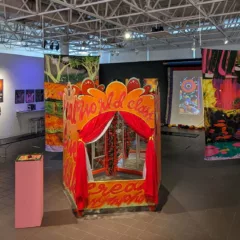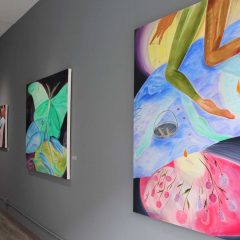
Mars the Red Planet, 1988, Plastic toy flamingos, barbie doll, fluorescent light, chalk, xerox, arches papaer, synthetic polymer with sparkle, oil stick, pastel; ensemble set on formica covered trapezoid wood base, 82 1/2 x 44 x 12 (artist’s comment: this sculpture relfects my fear of an impending nuclear holocaust).
Tom Kerr and Donna Martorana are sitting on a pile of art. It’s not even theirs. It’s the work of Mildred Elfman Greenberg, an artist with three works in the collection of the Philadelphia Museum of Art (here’s a post about her by Martin Bromirski at his blog, anaba).

Quartet: Ice Age to Space Age, III, 1990-91, toy animals, statue of liberty, palm tree, lion, skull, glass, red gravel, all placed within or on top of two plexiglas boxes set on a black Plexiglas base, 21 1/4 x 10 1/2 x 5″
During her lifetime, Greenberg had a career that any number of artists would yearn for, including representation in the 1940s New York World’s Fair, cultural exchanges, a Pollack-Krasner Foundation Grant, a lifetime achievement award from Moore College of Art and Design, and an extensive regional exhibition record including solo shows at places like Moore College of Art and Locks Gallery East, a retrospective at the Philadelphia Art Alliance, and lots of wifty out-of-the-way places as well as just about every place with gravitas in town.
Greenberg has one surviving heir, a daughter Susan, who, thanks to a brain injury incurred in a bike accident, is unable to handle the art that remains, and gets by on a small trust fund created after the bicycle accident.

Pegasus, 1987, ski boots, pegasus figures, teacup/saucer, toy snake, plexiglas, fractured glass, dinosaur (patina) enamel painted wood base
57 1/2 x 19 x 14″
So Susan’s friend Martorana, and Martorana’s husband, Kerr, a Powelton Village small-real estate owner, find themselves trying to help out with two goals: to get the art out of storage and seen, and to raise some money for the trust fund (created from the bicycle accident money) to help the injured daughter get by.
The art was locked up for six or seven years, said Kerr. First Susan’s sister was handling the work. “But there was no documentation of the things sold off. Then she died, and someone hired to handle it…there was distrust that involved a lack of records. Reluctantly we said we would do this. I have on my screen 315 works, and there’s more.” They have also discovered some works are missing–the originals of several posters Elfman made for the Painted Bride–but there’s no paper trail.
The problem is not unusual. In fact, it is typical.
Name an artist and I’ll name you someone with a pile of art. And that’s the problem. My friend Phillip worries about what his kids will do with all that art. Will they owe a pile of estate taxes because he’s sold several pieces at a high price? Will they have to pay storage fees for the rest of their lives? Will they know how to dispose of it appropriately? How will they even know the valuable work from the dross? Do they know the titles of what’s there? And then there’s the issue of where pieces on loan might be. And the records of what got sold to whom.
All of this comes down to art as a business. And a lot of artists, busy piling up their work, have not taken the time to keep records.
That’s where the Senior Arts Initiative comes in.
Founder Anne Kaplan was married to print maker and University of the Arts Professor Jerome Kaplan, who died 10 years ago with Parkinson’s disease. “The last three or four years of his life, he still continued to make art work, but everything was in a state of confusion of where his art was stored,” she said. As she started to inventory his work, she realized that other artists were in the same situation.
So she set up a panel discussion and then got funding to publish a series of guidelines for artists to get a grip. For DIY types, there’s a bunch of info here–some aimed at artists, some at their heirs. There’s also a free panel discussion coming up: Sunday, Nov. 4, 1 to 4 p.m., Michener Art Museum in Doylestown, registration required by calling 215-340-9800; gallery admission not included.
In addition, the eight sponsoring organizations of SAI, which include the likes of the Pennsylvania Academy of the Fine Arts, Temple University Tyler College of Art and The University of the Arts, take turns choosing artists who they think might be helped by SAI’s hands-on help.

Charlotte Schatz, Blue Windows, version 2
The Michener Museum, for instance, chose Charlotte Schatz for the full treatment.
“In my case I had three docents and curator in my studio for three different visits of four or five hours each,” Schatz said. The docents felt they learned a lot while I was picking up the work and we were photographing it. A video was made while this was going on (unedited)–there’s a set at University of the Arts in the library there; I think at Drexel there’s a set at the library.” [correction, 8/5/07: The oral histories are at the University of the Arts Greenfield Library and Woodmere Art Museum. People need to call for an appointment in order to view any of the videos. Anne]
Among the information cataloged in a notebook, said Schatz, was where each work was shown, the medium, size and date, and who bought it.

Only artists selected by participating institutions can get this level of hands-on help. But any artist can benefit from SAI’s expertise in other ways.
“It’s a tremendous service. It’s something an artist can do on their own if they go to one of these programs like the one at the Michener,” Schatz said. “We publish two booklets on how an artist can think about this.
“The thing is, most artists have all this inventory.” So Schatz advises artists to donate to institutions wherever possible. “Don’t leave it for your heirs, if not sold. Kids don’t know what to do with it.” And it often doesn’t even have market value.
Kaplan’s own experience shows that you can’t begin too soon.
“There were about 400 to 500 pieces,” she said. “Some of those works were editions of prints. I’ve been distributing it to museums for the past eight years. It’s a very labor intensive job and that’s why I feel so strongly about artists while they are alive should try to get the work organized and start to give work away.
“I’ve been fortunate that the curators that I’ve approached have for the most part been receptive. It’s getting more difficult. People used to take 30 or 40 prints, now they just take four or five. Storage space is filling up.”
As for Martorana and Kerr, they are using their business background to go step by step; first they took photographs. Then they learned that they needed to inventory the dimensions of the pieces. They are reaching out to all the names on Greenberg’s resume. Fortunately there’s one printed in the catalog from her 1996 retrospective exhibit at the Philadelphia Art Alliance. Meanwhile, they need to figure out which pieces have the most value. The money they raise by selling the work will go to the trust fund, to support their disabled friend. The rest they will try to give away. At least there will be a record of where everything went by time they get done.
SAI also holds exhibits of senior artists who have participated in the program. The fourth Biannual Senior Artists Exhibit is now up at the Woodmere Art Museum to Sept. 2. Exhibiting are Sister Helen David Brancato, Sandra Brownlee, Alan Goldstein, Jean Hamburg, Susanne Reese Horvitz, Mildred Hurwitz, Robert Jackson, Dan Miller, Barbara Mimnaugh, Elizabeth Osborne, Phill Powell, Rita Siemienski Smith, Mili Dunn Weiss, and Dennis Will.










